If you went to the doctor tomorrow because you don’t feel well… would you be satisfied with a diagnosis that just confirmed you’re sick? Or would you expect the doctor to prescribe a healthy treatment – so you get better? I’ll take a (not so) wild guess and assume you’d prefer the latter. And I’m the same way when I ask advice from any other professional consultant.
This is one of the reasons many business consultants I speak with use Pointerpro: To deliver personalized advice on auto-pilot (more about that below). Now, in any case, their advice is generally derived from a high-quality “readiness assessment,” “capability assessment,” or “performance index.”
Have you ever considered developing one of these three for your consultancy, but are you not quite sure which one suits your advisory service the most? In this little blog series, I’ll delve a little bit into each to help you understand the differences and the commonalities.
- The differences: Readiness assessment vs capability assessment vs performance index
- What is a readiness assessment?
- How to use any of these assessments to drive your consultancy business:
The next articles will focus on this:
- What is a capability assessment (coming soon)
- What is a performance index (coming soon)
The differences: Readiness assessment vs capability assessment vs performance index
If you’ve already read into this topic, you’ve probably come across another, similar term: “Maturity assessment.”
This term actually encompasses the three assessments this blog series focuses on.
In some contexts, it’s useful to apply the encompassing term because otherwise, “performance indexes” may get labeled as “readiness assessments,” and “readiness assessments” get labeled as “capability assessments” or vice versa.
The undesirable consequence in those cases? Consultancy customers end up confused or disappointed about the outcome that arises from the assessment. So it’s really even better to be precise and call your maturity assessment what it is exactly.
Each of these assessments differs in a number of subtle ways. Mostly: Their focus, their key purpose, their time orientation, and their expected outcome.
I’ve summarized them in the following table. Next, I’ll delve deeper into each individually. In this article, we’ll look at readiness assessments.
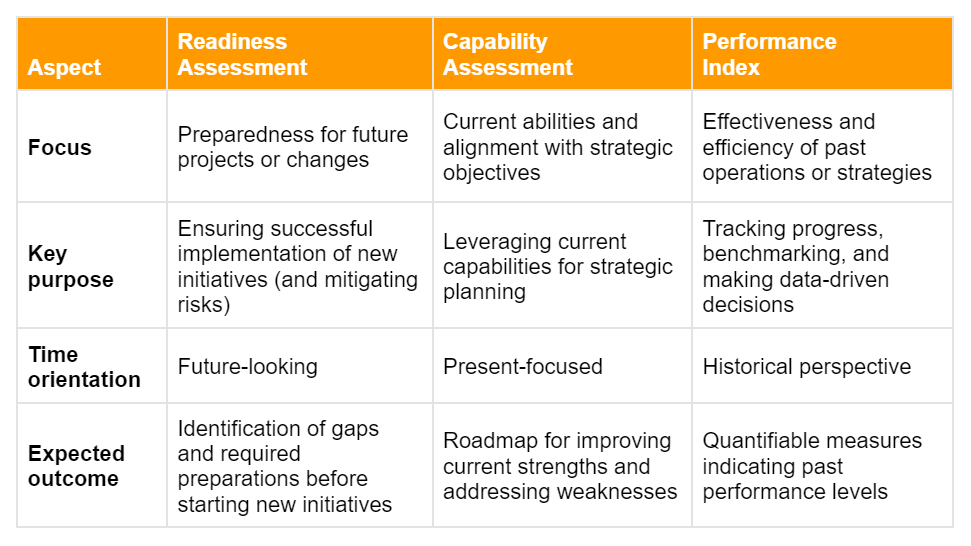
What is a readiness assessment, and when is it used?
A readiness assessment is a critical precursor to significant changes or new initiatives within an organization. It evaluates whether a business, a department, or a project team is prepared to move forward with a proposed strategy or change.
This includes scrutinizing resources, infrastructure, personnel competencies, and the organizational culture’s adaptability to change. The focus is on identifying gaps between the current state and the desired future state.
For instance, during COVID-19 (pre-and post), HR leaders were desperate to determine what steps were necessary to adopt remote and hybrid work. Why? Because they wanted to make sure these new, suddenly expected investments – like cloud-based tools and work-at-home allowances – weren’t going to end up being wasteful.
Essential readiness assessment steps:
- Define objectives and scope: Clearly outline the goals and boundaries of the readiness assessment, specifying the change initiative it focuses on (E.g., implementing a hybrid work policy).
- Develop assessment criteria: Identify the specific criteria that will be used to evaluate readiness. This may include financial resources, employee skills, technological infrastructure, and organizational culture.
- Create a quantitative model: Define the questions to include in your readiness assessment that will evaluate the different criteria. Attribute the appropriate importance to them on the overall evaluation. This means you’ll attach diverse weights or “scores” to all the answer options for each question.
- Develop your quantitative model into a prescriptive model: As mentioned, merely describing the current state of a consultancy customer is subpar in today’s competitive consultancy environment. Define the actionable advice you’d provide for every possible outcome of a respondent’s assessment.
- Pour your work into an assessment tool: Once all this homework is done, you just need to find a tool like Pointerpro, that allows you to turn it into a user-friendly assessment that generates a feedback report based on your prescriptive model.
If all this sounds a bit daunting, I assure you it’s not that complicated. To understand these steps in more detail, I recommend this article about quantitative maturity models by one of my colleagues. Basically, for the purpose of his article, he went through the preliminary steps for building a digital assessment (one that auto-generates advice).
Note: Combining a readiness assessment with a risk assessment
A readiness assessment assumes that an evolution from the current state to a different state is necessary. Therefore, its outcome may also be influenced by identified and measured risks related to the desired change process.
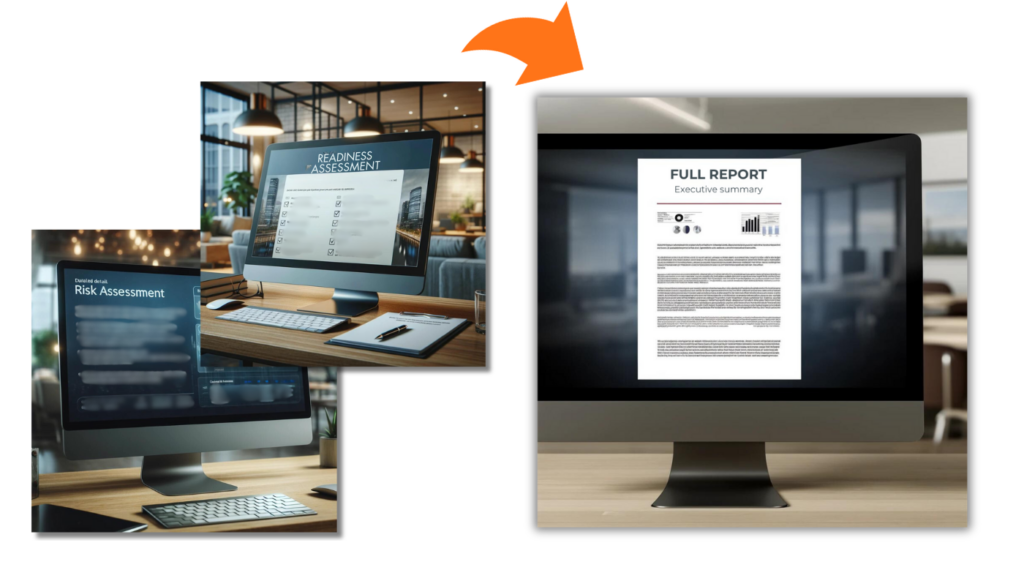
In other words, you’d have two assessments: One risk assessment and one readiness assessment. The readiness assessment report would take into account results from the risk assessment. That’s not very difficult. Especially if the assessment tool you use has the ability to generate full “group reports” based on different assessments’ response data.
How do I make a readiness assessment questionnaire? 3 fundamental tips
A questionnaire is about more than just asking the right questions. It’s not just about what you ask but also about how you ask it, in what order you ask it, what format you pour questions into, what answer options you give, how you formulate those answer options…
It all needs to serve your goal of accurately measuring readiness. To achieve that, this would be my baseline advice:
Be clear and precise:
Ensure that each question is concise and free of ambiguity. If you leave things open for interpretation, you might get inconsistent responses from respondents who are, in reality, on the same wavelength.
For example, in a readiness assessment for hybrid working, you might ask this question:

Seems straightforward?
It’s not quite, actually. “On a regular basis” means different things for different people. The assessor should have asked how comfortable the respondent is with “X times per week” or probably even have used a multiple choice question with 1, 2, 3, 4 or 5 work-from-home days as an answer options.
Consider question sequencing and flow:
Most of the time, it’s best to arrange questions in a logical order that follows a natural progression and to group together questions that are intended to measure the same criteria. It facilitates the respondent’s understanding.
However, sometimes, If your goal is to elicit more instinctive responses, you might want to do the opposite and shuffle things up. So even though for your score calculations, certain questions are grouped together, you’d still let these questions show up in a random order in the questionnaire for the respondent.
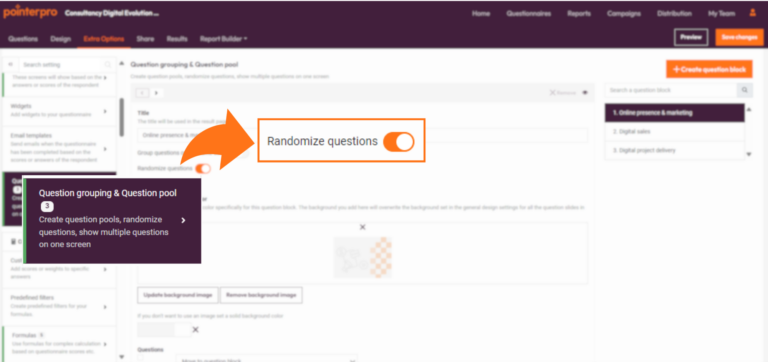
Provide balanced and meaningful answer options:
Offer a variety of answer options that capture the full range of possible answers. Throw in some Likert scales and alternate between positive and negative anchors (the default scale) to avoid response bias.
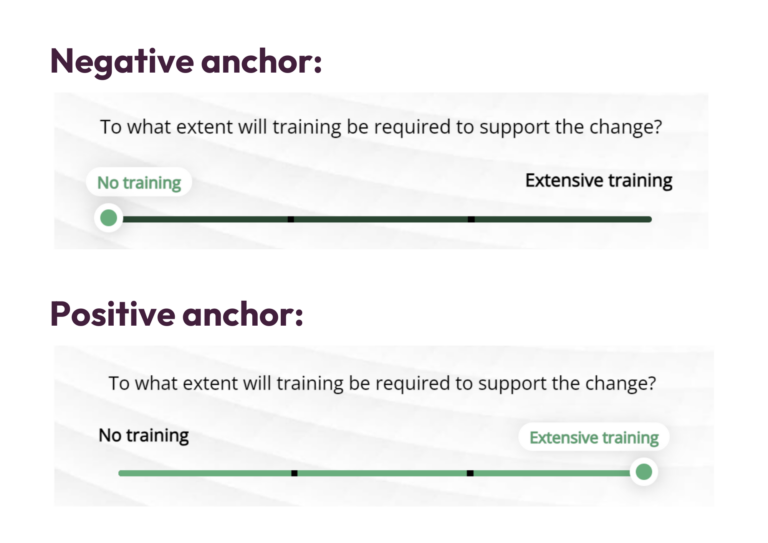
Include answer options like “I don’t know” or “I prefer not to answer” and consider attributing impactful scores to them. These things tend to say something about what you’re evaluating too, more than you’d expect.
What should I include in a readiness assessment report? 2 fundamental tips
The details of what you’ll include in your readiness assessment report will strongly depend on your specialization. But there are two things I can mention that are evergreen.
And that’s because of something called “the serial position effect.” It comes down to the tendency of people to remember what’s in the beginning and the end much more than what’s in the middle.
An executive summary:
Of course, it’s important to offer respondents and stakeholders an in-depth analysis in your report. After all, that’s what data collection through an assessment is for.
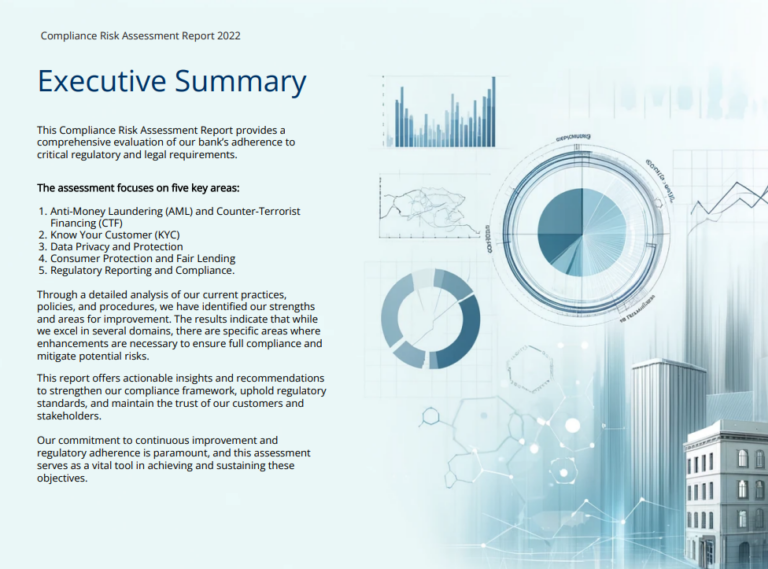
But don’t underestimate the importance of concision – especially for high-level stakeholders who may be reading along.
At the beginning of your report, highlight key findings and immediate areas of concern that come out of your readiness assessment. Really, this is so often forgotten.
An overview of the next steps (consider scenario planning):
Remember how I mentioned earlier that you should develop a “prescriptive” model when preparing your assessment? This is where it will pay off.
At the end of your report, outline a clear plan of action for improving readiness based on the outcome of the customer’s assessment. That includes conducting any further assessments that are needed or any other service you may be able to provide.
If you’re afraid that this comes off as a bland commercial attempt on your part, consider scenario-planning. It means you suggest potential future scenarios tailored to the outcome of your customer’s readiness assessment. These scenarios take into account possible future disruptive factors in their market, like for instance tech advancements or regulatory changes.
This way of presenting things makes your report very customer-centric. Of course, be sure to still clearly associate what services you can provide in each of those scenarios.
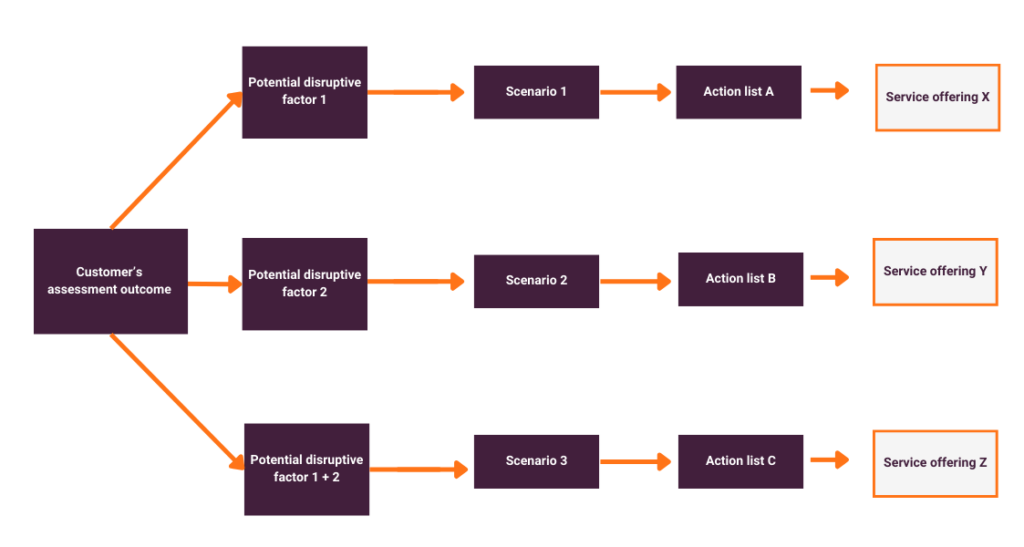
This proactive approach will help you and your consultancy stay top-of-mind in the longer term. It’s actually a form of what we call “guided selling.” In fact, many businesses use Pointerpro to build straightforward guided selling assessments based on this sort of model.
3 key ways to use a readiness assessment, capability assessment, or performance index
Readiness assessments, capability assessments, and performance indexes paint a comprehensive picture of an organization’s maturity. As discussed, this is why they’re often more generically coined as “maturity assessments.” Together, they collectively contribute to a holistic understanding of an organization’s maturity and performance over time.
’ll dive deeper into tips to optimize your capability assessments and performance indexes in the next two articles of this series. But since the three of these do have a lot of common ground, I’ll close this article by explaining what are their common use cases to advance a consultancy business:
- They help you generate new leads
- They’re useful tools to track existing customers
- They even allow you to productize your advice
I’ll dive into each below. Or, if you want to give your eyes a little rest, here’s a snippet on that topic from a webinar I hosted:
1. Lead Generation (or marketing)
Why?
Using a readiness assessment or any of the other types of maturity assessments is a great opportunity to analyze prospective customers. All the data you collect ultimately help you better understand the industry or market you’re targetting – even if not every respondent converts into an actual customer.
But say some prospects do become customers after engaging with your expertise via your readiness assessment. Not only will you then have attracted new sources of revenue, you’ll have done so without repetitively investing time in absorbing all the information from your prospects.
“But analyzing and reporting back on the assessment takes a lot of time and energy too!” is maybe what you’re thinking.
Well, here’s the kicker.
You can automate that part too – with Pointerpro. Essentially, it works as follows:
How?
With our Report Builder, Pointerpro users build a PDF report template that takes into account a respondent’s answers within a questionnaire. Based on the scores or formulas they’ve attributed to all of the answer options, a prospect’s readiness level is determined across one or multiple dimensions.
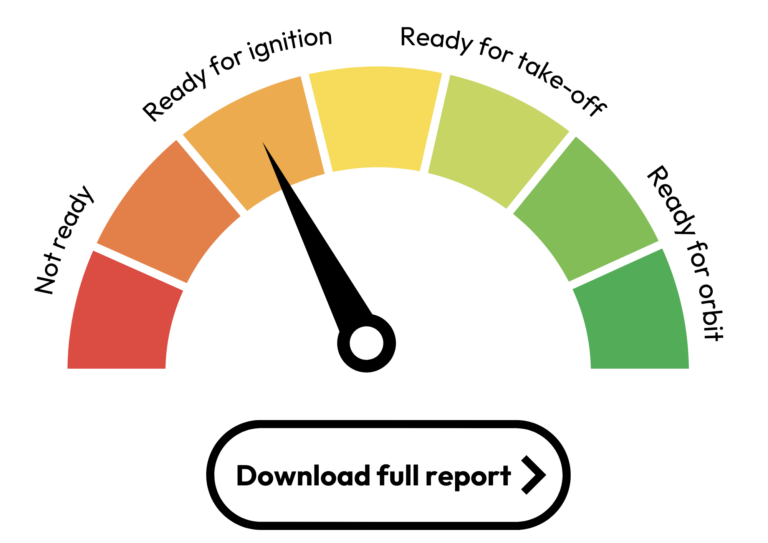
Based on those readiness levels – and if desired, based on many other variables – very specific recommendations, feedback, charts and visuals are automatically generated in the PDF. All prospects need to do at the end of their assessment is to click on a download button. And there they have it: Their personal report with the consultant’s specialized advice, for instance from a scale-up consultant like Chris Ellis.
2. Tracking existing customers
Why?
In once sentence: Because it allows consultants to keep track of their customers’ progress over time.
Typically, they’ll use one assessment to onboard a new customer at the beginning of their journey together, do a follow-up assessment a few months later, and another one at the end of the year.
How?
If you have individuals or organizations taking your assessment multiple times over the course of your engagement with them, you can filter and analyze the various responses over time from that customer. You’d do this to measure what’s changing for the better and, potentially, what’s changing for the worse.
Of course, you especially want to provide feedback on how to stay or get back on track. And again, if built with Pointerpro, each time an assessment is taken, the PDF report with those highly variable recommendations – is auto-generated.
One additional tip, in case you start operating this way this: Think about upselling and cross-selling services in your consulting report.
3. Productization
Why?
Well… Why not? If you’re delivering value to each person or organization going through a readiness assessment, it’s probably a product you’d be able to sell too. And there are easy ways to do so.
One such way is to productize and trademark your assessment methodology. You can then allow other consultants in your domain to subscribe and use your assessment for their practices. Not only will you generate a lot of passive income that way, you’ll actually build your brand – like ResilienceBuilder®, for example.
Of course, you may just as well sell your assessment directly to end customers. The time-efficiency of advice consulting through assessments with automated PDF reports is not only advantageous for you as the consultant. Every manager or organization is constantly looking to save time too. So there’s an unmistakable win-win.
How?
There are quite a few ways to monetize your readiness assessment. Let me assume you don’t have a webshop. That’s no problem at all. There are a few simple strategies.
In your online assessment flow, you simply need to integrate a payment link that’s connected to your bank account (in Pointerpro you can use PayPal or Stripe). So instead of asking a question at a certain point in your questionnaire, you’re inviting your respondent to pay.
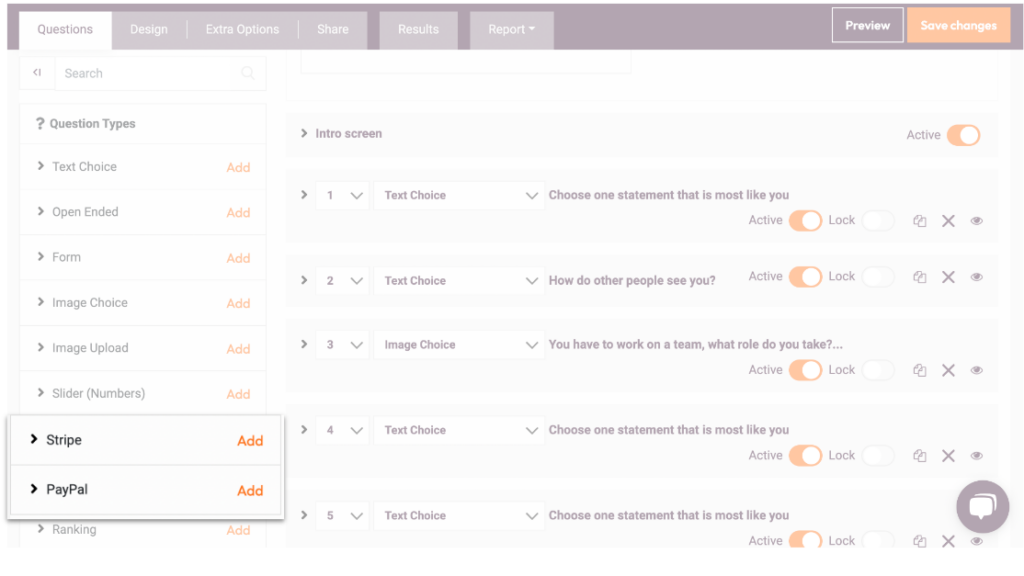
- Strategy 1: You do this at the very beginning of your questionnaire.
- Strategy 2: You do this somewhere in the middle of your questionnaire (get them hooked first, but request payment to proceed).
- Strategy 3: You do this at the very end of your questionnaire and basically require your respondents to pay in order to be able to download their personalized PDF report. To get them over the fence, you can tease them with an overall result on your questionnaire’s outcome screen.
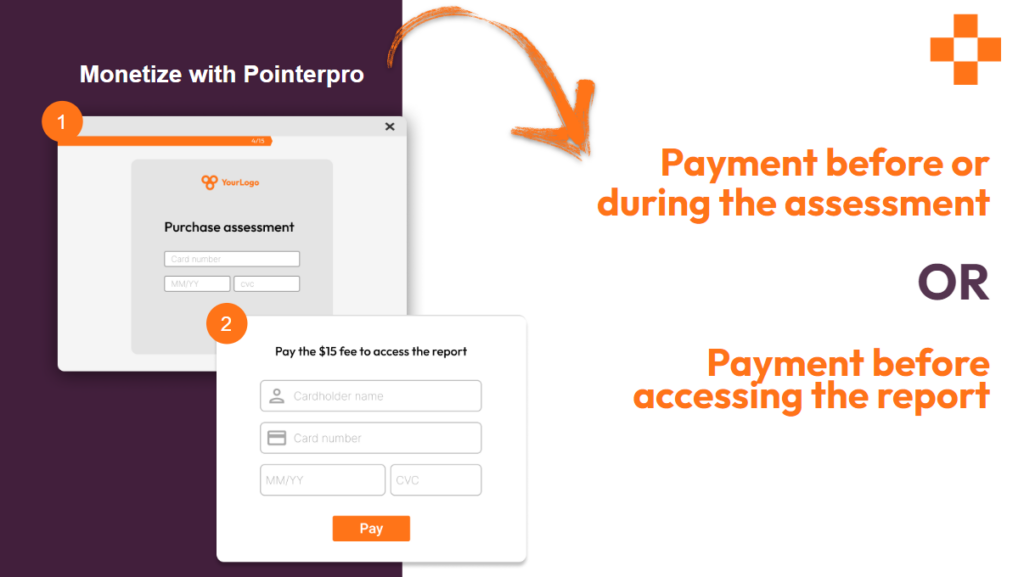
Coming up in this mini-series:
In the next article, I’ll focus on the nuts and bolts of capability assessments. And while I’m at it, I’ll also explain what are the 3 key features needed in a capability asessment tool (or readiness assessment tool, or performance index tool) – in order to automate your advice delivery.
Interested, but can’t wait? Feel free to book a free discovery call with me. I’d be more than happy to get you excited about everything you can achieve with our Pointerpro platform!
PS. If you’re in Europe – assuming you don’t want to do this discovery call at night – you’ll get talk to my colleague Stacy. She explains it all just as well as I do, I promise!



